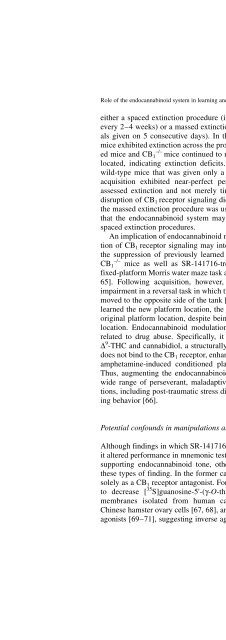3. Umbruch 4.4..2005 - Online Pot
3. Umbruch 4.4..2005 - Online Pot
3. Umbruch 4.4..2005 - Online Pot
You also want an ePaper? Increase the reach of your titles
YUMPU automatically turns print PDFs into web optimized ePapers that Google loves.
Role of the endocannabinoid system in learning and memory 123<br />
either a spaced extinction procedure (i.e. a single 60-s extinction trial given<br />
every 2–4 weeks) or a massed extinction procedure (i.e. four daily 120-s trials<br />
given on 5 consecutive days). In the spaced extinction task, the control<br />
mice exhibited extinction across the probe trials, while both SR-141716-treated<br />
mice and CB 1 –/– mice continued to return to where the platform had been<br />
located, indicating extinction deficits. Importantly, an additional group of<br />
wild-type mice that was given only a single probe trial 9 weeks following<br />
acquisition exhibited near-perfect performance, indicating that this task<br />
assessed extinction and not merely time-dependent forgetting. In contrast,<br />
disruption of CB 1 receptor signaling did not alter the rate of extinction when<br />
the massed extinction procedure was used. Collectively, these results suggest<br />
that the endocannabinoid system may play a specific role in long-term or<br />
spaced extinction procedures.<br />
An implication of endocannabinoid modulation of extinction is that disruption<br />
of CB 1 receptor signaling may interfere with learning tasks that require<br />
the suppression of previously learned responses. In support of this notion,<br />
CB 1 –/– mice as well as SR-141716-treated mice learn the location of the<br />
fixed-platform Morris water maze task at identical rates to wild-type mice [40,<br />
65]. Following acquisition, however, CB 1 –/– mice exhibited a significant<br />
impairment in a reversal task in which the location of the hidden platform was<br />
moved to the opposite side of the tank [40]. While the wild-type mice readily<br />
learned the new platform location, the CB 1 –/– mice continued to swim to the<br />
original platform location, despite being repeatedly shown the new platform<br />
location. Endocannabinoid modulation of extinction also has implications<br />
related to drug abuse. Specifically, it has recently been demonstrated that<br />
∆ 9 -THC and cannabidiol, a structurally related component of marijuana that<br />
does not bind to the CB 1 receptor, enhances extinction of cocaine-induced and<br />
amphetamine-induced conditioned place preference learning in rats [66].<br />
Thus, augmenting the endocannabinoid system may be useful in treating a<br />
wide range of perseverant, maladaptive behaviors related to aversive situations,<br />
including post-traumatic stress disorders [14] and persistent drug-seeking<br />
behavior [66].<br />
<strong>Pot</strong>ential confounds in manipulations altering CB 1 receptor signaling<br />
Although findings in which SR-141716-treated animals or CB 1 –/– mice exhibit<br />
altered performance in mnemonic tests are generally interpreted as evidence<br />
supporting endocannabinoid tone, other explanations can also account for<br />
these types of finding. In the former case, SR-141716 does not appear to act<br />
solely as a CB 1 receptor antagonist. For example, SR-141716 has been found<br />
to decrease [ 35 S]guanosine-5'-(γ-O-thio)triphosphate (GTPγS) binding in<br />
membranes isolated from human cannabinoid CB 1 receptor-transfected<br />
Chinese hamster ovary cells [67, 68], an effect opposite to that of cannabinoid<br />
agonists [69–71], suggesting inverse agonist activity. Since cannabinoid ago-







